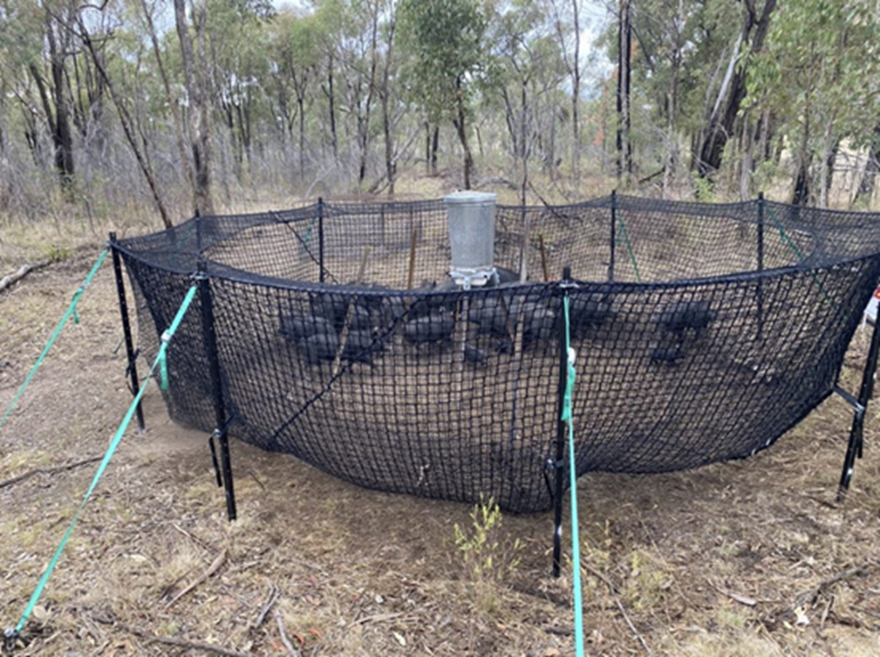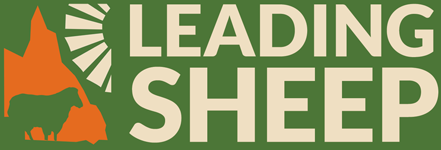- Quick picks: dog activity, safety signs, confinement feeding and worm ready.
- Deep dive – Pigs a problem? Research and control.
- Upcoming events
- Podcasts, eBulletins and surveys
Quick picks
Wild dogs on the prowl: There are reports of increased wild dog movements in some areas. We received the following photos and words of wisdom “Wild Dogs are bait shy, is sometimes heard (perhaps as an excuse not to bait). This dog was not. It ate this 1080 bait and returned 20 minutes later for more. The dog exited under the camera towards another bait.”


Sheep and goat eID rebate now open. Queensland sheep and goat electronic identification (eID) rebate has opened as part of the rollout of mandatory eID tags from 1 January 2025.
The assistance package will provide:
- Eligible sheep and goat producers a 50% rebate up to $1600 per PIC for eID readers and identification tags
- Eligible QLD livestock agents a 50% rebate up to $1600 for eID readers
Safety signs: Look after your team and yourself by ordering a shed safety signage kit from Australian Wool Innovation. To order a kit for your woolshed, follow this link and fill out the form. Shed Safety Signage Kit Order Form (wool.com)
Effects of ivermectin on soil nutrient cycling, plant biomass and dung beetle abundance: A study published in the June 2024 edition of the Rangeland Journal examined the impact of ivermectin on dung beetle abundance and subsequent soil nutrient concentrations and plant growth during spring and summer in South Dakota grassland. The study found that beetle abundance was 50% greater in dung pats without ivermectin, especially when the dung was fresh. The study also found Ivermectin concentrations did not change N content in dung or plants, or change plant biomass. I haven’t seen any prairie dogs running around Southern Queensland lately, but drenches and dung beetles have been a recurring point of discussion at Leading Sheep workshops. Read the full research article here.

Worms: Most producers I have spoken to recently are getting low worm egg counts, but don’t let your guard down. You don’t want your profits eaten away when worm burdens start to rise. If there is a lull, it is a good time to decide where you will get your worm egg counts done and to order test kits if you plan to send them to a lab. If you have someone local who can do your counts, call them to make sure they are still available and confirm how much notice they need. This might save you being caught short later in the year.
Productive Producer podcast about confinement feeding sheep: Join Max Newsome (Local Land Services, NSW Government) and Geoff Duddy (sheep consultant) as they discuss the ins and outs of confinement feeding sheep. Learn how to set up the perfect confinement area, what to feed your animals and why it’s essential to consider their wellbeing in the process. Find it here on Spotify or copy this link into your browser https://open.spotify.com/episode/3tofCGtqo1AFSlwMIbeYj4 .
Careers booklet: Do you know any young people who could be interested in a career in wool? AWI has a career booklet that details the diverse roles available. It includes real-life stories from people working in the industry, along with their advice on what’s needed to be successful and how to make the most of the opportunities. Click here to access the booklet.
Deep dive – Pigs a Problem? Research and control.
While counting worm eggs at recent workshops, the conversation turned to the problems caused by pigs in the paddock. A producer recently showed me a video of a pig attempting to eat a young goat. This month’s deep dive explores recent research findings from collaring projects tracking pig movements and trials of new traps.
A recent study published in Wildlife Research by Cameron Wilson and Matthew Gentle (Queensland’s Department of Agriculture and Fisheries) and Darren Marshall (Southern Queensland Landscapes) might interest sheep producers.
The research focused on:
- how far and where feral pigs move in their environment (activity ranges)
- feral pigs’ preference for different habitat types.
The research was carried out at four locations in eastern Australia, covering diverse landscapes including agricultural regions, gas exploration sites and a tropical island. Feral pigs were fitted with GPS tracking devices, enabling researchers to track their movements over several months.
The study found the activity range of feral pigs was influenced by sex, location and body mass. Season or year did not have a significant effect. A consistent observation across all sites was the pigs’ preference for habitats with between 20% and 40% foliage cover. This result differed from previous Australian research findings that pigs preferred to seek cover in heavily covered areas.
What does this mean on the ground? Targeting areas with between 20% and 40% foliage could yield improved pig control at a significantly reduced cost. Sheep producers are spread across a wide array of land types in Queensland, so this may not apply to everyone.
Other studies within the last year have found that, especially in seasons favourable to the reproduction of pigs, the race to lower the population of pigs is against the pig’s ability to breed up again rather than pigs coming in and filling the vacuum that was left.
I recently listened to a webinar sharing key learnings from a project monitoring feral pig movements during intensive aerial and on-ground culling operations conducted by NSW Local Land Services. In Northern NSW, an intensive control program was performed with monthly aerial shooting and weekly baiting and trapping programs. What I heard was that, especially in seasons favourable to the reproduction of pigs, the race for control is against the pig’s ability to breed up again at a relatively quick rate. It was found that other pigs did not rapidly move to fill the vacuum, nor did the resident pigs flee the controlled area – they chose to remain within their normal home range within the control zone. You can watch the webinar here: or copy this link into your browser https://www.youtube.com/watch?v=6jNCTefwHYs .
Also, Local Land Services has been testing new netting-style traps and have found them largely successful. Having seen them in person, I was surprised by how sturdy they were when set up. The netting at the bottom of the trap can be tied like a curtain, allowing the pigs to walk in freely. When it is time to set the trap, the netting sits on the ground inside. This means pigs can walk under the netting to enter the trap but cannot get back under the netting to walk out.

Here are some pointers from producers effectively managing pigs:
- When ground baiting or trapping, free feeding before setting the trap or laying the bait is crucial to success. The longer you can free feed, the better.
- Coordination is key. The more people undertaking pig control at the same time across the landscape, the more effective it will be.
As noted above, coordination between neighbours is an essential part of any pest control program, whether it be baiting, trapping or aerial shooting. Desert Channels Queensland and the South West Queensland Regional Organisations of Councils Inc. have received grant funding to employ four feral pig management coordinators across Queensland. Under Round 8(b) of the Queensland Feral Pest Initiative, the coordinators will deliver activities to support effective feral pig management. Once the coordinators are appointed, I will share their contact details.
If you want to discuss the above further or share some wisdom in future newsletters, please call me on 0400 257 427 or email sam.harwood@daf.qld.gov.au.
Written by DAF extension officer Sam Harwood.
Resources mentioned in the above deep dive
- Research paper: Factors influencing the activity ranges of feral pigs (Sus scrofa) across four sites in eastern Australia
- National Pig Action Plan stakeholder forum: Hear key learnings about feral pig movements during intensive aerial and on-ground culling operations conducted by NSW Local Land Services. https://www.youtube.com/watch?v=6jNCTefwHYs .
- AWI Extension NSW webinar on pig control: https://www.youtube.com/watch?v=BS2SdVWKRXA
Upcoming events
- 12-14 August. Breeding EDGE, Longreach. Delivered by Désirée Jackson Livestock Management. For more information and to register, click here.
- 14-20 August. GrazingforProfit, Roma. Delivered by RCS. For more information and to register, click here.
- 26 August. Cattle and Grain Industry update, Muckadilla .Delivered by AgForce. For more information and to register , click here.
- 27 August. Cattle and Grain Industry update, Woodlands (Dunkeld).Delivered by AgForce. For more information and to register , click here.
- 28 August. Cattle and Grain Industry update, Moonie .Delivered by AgForce. For more information and to register, click here.
- 29 August. Cattle and Grain Industry update, Miles .Delivered by AgForce. For more information and to register, click here.
- 3 September. Farm business resilience planning workshop, Condamine . Delivered by ConnectAg . For more information and to register click here.
- 4 September. Farm business resilience planning workshop, Westmar . Delivered by ConnectAg . For more information and to register click here.
- 4 September. Integrated Weed Management day ‘ Sommarvia’, Charleville .Delivered by DAF. Save the date keep eye out for the registration.
- 4 September Containment feeding workshop, Roma. Delivered by DAF. Save the date keep eye out for the registration.
Podcasts, eBulletins and surveys
- Around the Camp Leading Sheep podcast
- AuctionsPlus Sheep Results and Catalogue
- AWI Beyond the Bale magazine
- AWI The Yarn podcast
- AWI Weekly Wool Market Report
- Farm Biosecurity News
- MLA Prices and Markets
- Sheep Producers Australia News
- Wool Producers Australia News

